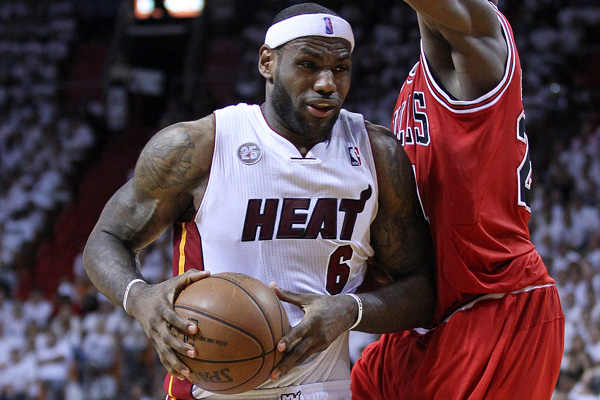
Photo: John J. Kim/Chicago Tribune
LeBron: The next Jordan? The ongoing debate now has some stats to back it up.
Having a newborn means I haven't gotten to watch much of the NBA playoffs—I try to give myself an 11-hour window to get something that functions like seven hours of good sleep. But the NBA finals were clearly excellent, so I stayed up, sleep be damned, to catch all of game seven.
And it was worth it. First for the aesthetically pleasing matchup of Christopher Claus Andersen and Tim Duncan—the former a charitable, day-glo tattooed one-time group-home resident, whose path to the NBA led from a juco in southeast Texas to the Jiangsu Nangang Dragons to the Fargo-Moorhead Beez of the IBL, the latter a famously taciturn four-year college star and number-one pick. A wonderful, textured diversity of roads lead to the NBA.
Second, the memento mori of Manu Ginobili. For years he could get away with an insensible style, teetering on the edge of control, because of his speed and instincts. At 35 he's lost just enough speed and court vision that it's as likely to translate into a disaster, like his nine-point, eight-turnover line in game six, as his brilliant 24-point, three-turnover line in game five.
And then there's LeBron, and the question he's had since his first NBA game: could he ever match Michael Jordan?
For years, it didn't look like it, but he was trapped on an incompetent Cleveland team incapable of assembling a capable supporting corps. The last insult was Antawn Jameson, the addition of a much older, much worse player with a similar skill set. Now that he's won back-to-back championships with back-to-back MVP awards, the discussion has resumed. And James seems to have about 25-35 minutes of MJ in him per game—if he can't do it all the time, he can seemingly do anything long enough for his team to be better than any other (when it needs to be).
And the numbers are starting to bear that out:
San Antonio spent the first six games of this series daring LeBron to shoot, and for the most part, it worked. There’s one major flaw with that strategy, though — LeBron can shoot. James’s 40.6 percent 3-point shooting mark in the regular season was the best of his career by more than four percentage points. On jump shots from 16 to 24 feet, James went from 38.4 percent last season to 44.7, which puts him among the elite.
[snip]
Last season, James shot that last midrange dagger at about 42 percent. This season, it was 59 percent. James was asked last night if he’s unstoppable when that jump shot is falling. “Yeah, I am,” he replied, and I’m not sure who could say otherwise.
Nate Silver calculates James's odds of a three-peat at "probably about one-in-three," a lot of wiggle room based on the realities of the body:
More important, players in team sports typically see their skills peak in their mid-to-late 20s, meaning that James’s game might also begin to wane. The N.B.A. is a superstar’s league, and if James goes from being M.V.P.-caliber to mere All-Star by a few years from now, it will hurt his odds of winning further titles considerably.
This is where James's increasing skill at mid-range jumpers becomes significant. As he loses his ability to slash and steamroll, will he adjust his game to match his age (like Duncan), or persist in diminishing returns (like Ginobili)?
It's worth recalling what Jordan did. As Phil Taylor wrote in 1999, Jordan developed his murderous fadeaway during his baseball sojourn, as a response both to where he found himself and where he saw himself going:
He was no longer the basketball stuntman who treated gravity as a suggestion rather than a law. He had toned down his game, deciding that at 32 the time had come to be more efficient than spectacular. That was evident almost from the first moment of the first game of his return. Jordan was ready to unveil a new style, and its signature was the fadeaway jump shot.
He had refined the shot in pickup games with his Birmingham Barons teammates. Jordan wasn't going to risk driving to the basket against a bunch of amateurs who might unintentionally hurt him, so he contented himself with turning and shooting over them, falling back as he released to keep himself out of harm's way.
Jordan himself said that the fadeaway worked early on because opponents were guarding his old game, giving him room for his jumper. By the time they adjusted, it was so well-developed it was practically impossible to stop. (I always wanted Nike to follow up the "Jumpman" logo with a "Fadeawayman," possibly targeted to the 35-and-up market.)
James isn't as balletic as Jordan was; even if he's able to incorporate a Jordan fadeaway, it won't look so damn pretty. But he's learned to work with the body he has, and is preparing his game for the body he will have, which he'll need to do in order to follow in Jordan's footsteps.


